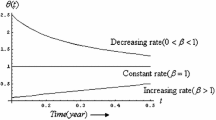Abstract
The impact of stockout has been underlined in many consumer studies. According to them, stock-out affects consumers’ purchase decisions and this is especially true on online shopping. In this paper, an inventory model is considered, under the classical EOQ framework, by assuming that shortages affect the customers’ demand. To this end, during shortages period, the demand rate decreases proportionally to the existing backlogging. Then, in order for the total cost to be obtained, the backlogged demand rate is approximated by a piecewise constant function. For this approximated model, the reorder interval, that minimizes the total cost, is determined in closed form. Comparisons, through numerical examples, between a specific backlogging rate (already used in the literature) and the proposed approximation, indicate that this approximation gives high quality results.

Similar content being viewed by others
References
Abad PL (1996) Optimal pricing and lot-sizing under conditions of perishability and partial backordering. Manag Sci 42:1093–1104
Anderson ET, Fitzsimons GJ, Simester DI (2006) Measuring and mitigating the cost of stockouts. Manag Sci 52:1751–1763
Bakker M, Riezebos J, Teunter RH (2012) Review of inventory systems with deterioration since 2001. Eur J Oper Res 221(2):275–284
Balakrishnan A, Pangburn MS, Stavrulaki E (2004) ‘‘Stack them high, let ‘em fly’’: lot-sizing policies when inventories stimulate demand. Manag Sci 50:630–644
Boatwright P, Nunes J (2001) Reducing assortment: an attribute-based approach. J Mark 65:50–63
Breugelmans E, Campo K, Gijsbrechts E (2006) Opportunities for active stock-out management in online stores: the impact of the stock-out policy on online stock-out reactions. J Retail 82:215–228
Cárdenas-Barrón LE, Sana SS (2015) Multi-item EOQ inventory model in a two-layer supply chain while demand varies with a promotional effort. Appl Math Model 39:6725–6737
Cárdenas-Barrón LE, Chung KJ, GerardoTreviño-Garza G (2014) Celebrating a century of the economic order quantity model in honor of Ford Whitman Harris. Int J Prod Econ 155:1–7
Chung KJ, Cárdenas-Barrón LE (2012) The complete solution procedure for the EOQ and EPQ inventory models with linear and fixed backorder costs. Math Comput Model 55:2151–2156
Gershwin SB, Tan B, Veatch MH (2009) Production control with backlog-dependent demand. IIE Trans 41:511–523
Giri BC, Bardhan S (2015) A vendor–buyer JELS model with stock dependent demand and consigned inventory under buyer’s space constraint. Oper Res Int J 15:79–93
Kazemi N, Shekarian E, Cárdenas-Barrón LE, Olugu EU (2015) Incorporating human learning into a fuzzy EOQ inventory model with backorders. Comput Ind Eng 87:540–542
Konstantaras I, Skouri K, Jaber M (2012) Inventory models for imperfect quality items with shortages and learning in inspection. Appl Math Model 36(11):5334–5343
Padamanabhan G, Vrat P (1995) EOQ models for perishable item under stock dependent selling rate. Eur J Oper Res 86:281–292
Pentico DW, Drake MJ (2011) A survey of deterministic models for the EOQ and EPQ with partial backordering. Eur J Oper Res 214:179–198
Pentico DW, Toews C, Drake MJ (2015) Approximating the EOQ with partial backordering at an exponential or rational rate by a constant or linearly changing rate. Int J Prod Econ 162:151–159
Rao US (2003) Properties of the periodic review (R, T) inventory control policy for stationary stochastic demand. Manuf Service Oper Manag 5:37–53
Taleizadeh AA, Mohammadi B, Cárdenas-Barrón LE, Samimi H (2013) An EOQ model for perishable product with special sale and shortage. Int J Prod Econ 145:318–338
Teng JT, Krommyda IP, Skouri K, Lou KR (2011) A comprehensive extension of optimal ordering policy for stock-dependent demand under progressive payment scheme. Eur J Oper Res 215:97–104
Zheng YS (1992) On properties of stochastic inventory systems. Manag Sci 18:87–103
Author information
Authors and Affiliations
Corresponding author
Rights and permissions
About this article
Cite this article
Skouri, K. An EOQ model with backlog-dependent demand. Oper Res Int J 18, 561–574 (2018). https://doi.org/10.1007/s12351-016-0279-0
Received:
Revised:
Accepted:
Published:
Issue Date:
DOI: https://doi.org/10.1007/s12351-016-0279-0




